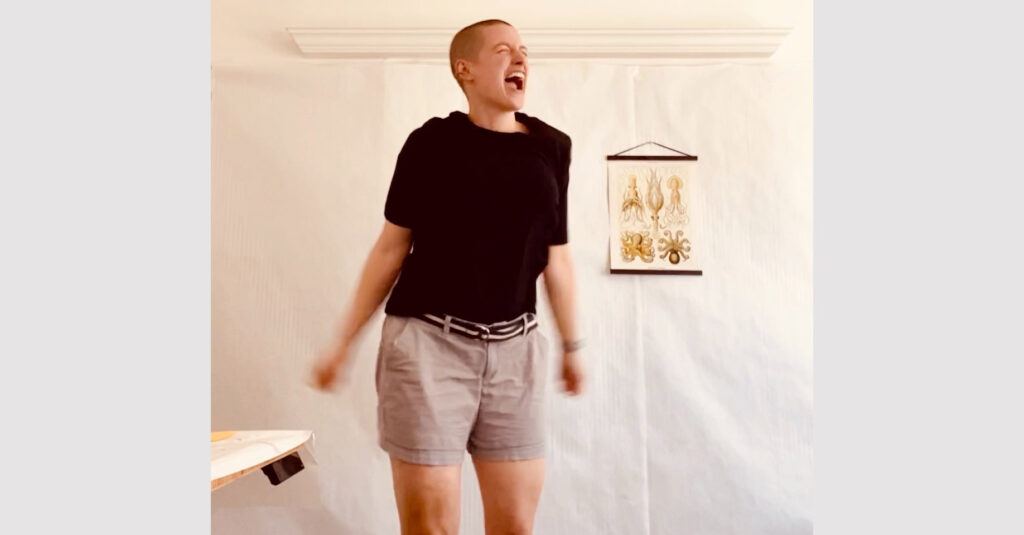This post was originally published at SarahDopp.com in the months leading up to the launch of Queer ADHD. We’ve migrated these posts to the Queer ADHD blog for continuity.
I have a complicated relationship with my body, and it’s been a struggle to learn how to care for it. Growing up, I was tall for my age—at one point, a full head taller than everyone else in the lunchroom line—and this meant a long phase of feeling lanky and uncoordinated. I also inherited my father’s large frame and muscular build, which tragically resulted in deep body shame (“girls aren’t supposed to look this way”) instead of athletic inclination. Gym class and team sports felt like a punishment, but I was otherwise a straight-A student, so I shaped my identity entirely around my mind and what I could accomplish with it. On good days, my body was a stranger that I didn’t acknowledge. On bad days, it was an enemy I had to fight.
That pattern changed very slowly, starting in my mid twenties, and only out of necessity. (It turns out if you sit at a computer for 12 for hours a day without breaks, things start going sideways.) I fell apart, I asked for help, I tried dozens of different things, and I cried about most of them. I abandoned plans to exercise far more often than I followed through with them. But slowly, I learned more about myself, and a few practices started to stick. I also stopped calling it exercise because that word is loaded with feelings of obligation and never being good enough. Now I call it movement.
Today—while I’ve been working from home during the global pandemic—I have a gentle and willing relationship to movement, but it’s also inconsistent, and that’s okay. I’ve let my movement practice adjust to wherever I am in the 2020 emotional ping-pong of anxiety vs calm, depression vs determination, and fogginess vs clarity. This flexibility is also important for respecting my ADHD—my brain is wired for interest, and won’t maintain a practice without variety and enjoyment.
Here are the principles that have worked best for my movement practice during the pandemic:
1) Put joy first.
If I don’t enjoy it, I won’t continue with it. This seems obvious now, but took me an embarrassingly long time to learn—who could have guessed that if you like something, you’re more likely to do it? I spent years truly believing that I would never enjoy movement, so I focused on finding ways to get the biggest health benefits for the least amount of time. These strategies were brutal (whoever dreamed up “The 7-Minute Workout” is a sadist), and they never lasted more than a few sessions.
I’ve since learned there is movement I can—and very much do—enjoy. Dancing feels transcendent when I have the right music. I love to take long walks in beautiful places. I think elliptical machines are fun when I pair them compelling music, reality tv shows, or strategy games on my iPad. These practices consistently help me feel good.
2) Foundational work needs accountability.
Unfortunately, walking, dancing, and machine cardio don’t address all of my movement needs. My neck and back need special attention to counter the time I spend at a computer. I also have a bad habit of injuring myself while dancing, but it happens less often if I work on strength and flexibility. Finding joy in solving for these areas is… a challenge for me.
In one of the bravest moments of my thirties, I followed the lead of several friends and started working with a personal trainer team in the Bay Area called The Fitness Alchemists. I chose them because they were explicitly focused on helping people understand and trust their own bodies. They also made it clear they would tailor the program to my level, and would be sensitive to my resistance and fears. Working with professionals has given me accountability—I’m more likely to show up if I know someone’s invested in it. I’m also able to let go of planning my own program, which is a relief. What has surprised me, though, is how much this work has helped me understand that I am the expert of my own body.
3) Conscious movement improves my relationship with my body.
In the frequently-recommended book, The Body Keeps the Score: Brain, Mind, and Body in the Healing of Trauma, the author explains that healing needs both a “top-down approach,” like talk therapy, and a “bottom-up approach,” like yoga. This struck a chord for me. After reading it, I started focusing on slower and more attentive movement practices to help heal my relationship with my body.
My work with personal trainers usually falls into this category because they constantly ask me to go slower, breathe, and pay attention to my current range of motion. Sometimes I also bring extra attentiveness to walks or dance, and really focus on how I’m shifting my weight or on how each part of my body feels. While it’s hard to know exactly what these conscious practices are doing for me, I do feel in my bones that they are helping me… um, feel my bones. And get to know my body. And trust it.
4) Unconscious movement has its place, too.
Some days, I just cannot gather the willingness to show up and be fully present for conscious movement, even if it was my plan. I really just need to zone out. When my choice is between Following My Plan or Giving Up Entirely, I add a third option: getting my heart rate up while I’m focused on something else. One way I do this is to take a long walk while listening to fascinating podcast (shout out to the teams at You’re Wrong About and By The Book—thank you for keeping me sane!). Another is loading up one of the iPad games that are so addictive that I don’t let myself play them anymore (like Plants vs Zombies or Mini Motorways), and play it while I’m on the elliptical. Time passes, my body moves, and maybe I didn’t fully show up for it, but it still helps.
5) When I don’t want to do anything, I might be willing to do everything at once.
This was my favorite ADHD hack of trying to actually get work done during the 2020 pandemic: when my fuck-its are so strong that I’m not willing to show up to my workout mat or to my laptop, I bring my laptop to the mat. Do one strength rep, then answer one email. Dance for five minutes, then write a paragraph of documentation. Repeat for as long as it takes to feel like I’ve made progress. Weirdly, this makes both efforts more tolerable because I’m playing them against each other, letting one be the procrastination of the other. Every time I’ve done it, it has energized me and unblocked me.
6) Go outside.
I’ll admit, I took this one for granted at the beginning of the pandemic lockdown. I thought that getting fresh air was just the bonus of taking lots of walks, but it turns out that going outside is crucial for my mental health. When I only did indoor movement, my world started to feel very small. I even found that I sometimes need to focus my eyes on a distant horizon—it gives me a strange feeling of relief after spending weeks limiting my view to walls and windows.
I live in California, and that means that about five months into our pandemic lockdown, we dealt with nearly two months of wildfire smoke that was dangerous to breathe. Our ability to enjoy the outdoors was shut down. I lasted three weeks into this before I got in my car and drove to Utah, just to be able to sit outside again. After that, I invested in good hiking gear and vowed never again to take fresh air for granted.
7) Minimize decision-making, but keep it flexible.
I designate time every weekday for movement, and I have an outline in advance of what practices I’ll be doing each day. I also keep a physical checklist on my desk of what I need to grab before I begin (iPad, headphones, heart rate monitor, water—check!). My goal is to remove any required decision-making. I want to Just Show Up and Do The Thing.
At the same time, though, I show myself a lot of empathy when my plan just doesn’t feel like it’s going to work that day. I have fallback strategies and easier options. For example, “just do the first set,” or “just get a walk in,” or “it’s ok to multitask on this one.” If I go a full week without being able to follow my plan, then I think through how my plan needs to change. It’s a constant game of negotiation, and my commitment is to support myself. I am never “bad” for not moving as planned; my behavior is a complex puzzle and I am always paying attention to it so I can adapt.
***
The self-kindness in these approaches has been paying off in a really obvious way: I’m now at the point where I crave movement. I notice when I’m not getting enough of it and I seek it out. I’m aware of how it helps me, and I reach for it as a strategy I can trust. It’s become a part of my identity and a reliable tool in my toolkit. I’m still not the kind of person who will push myself competitively or set goals for how much I can bench press, and that may never be me. But I am a person who is learning to trust my tall, strong body, and I am letting it dance.

